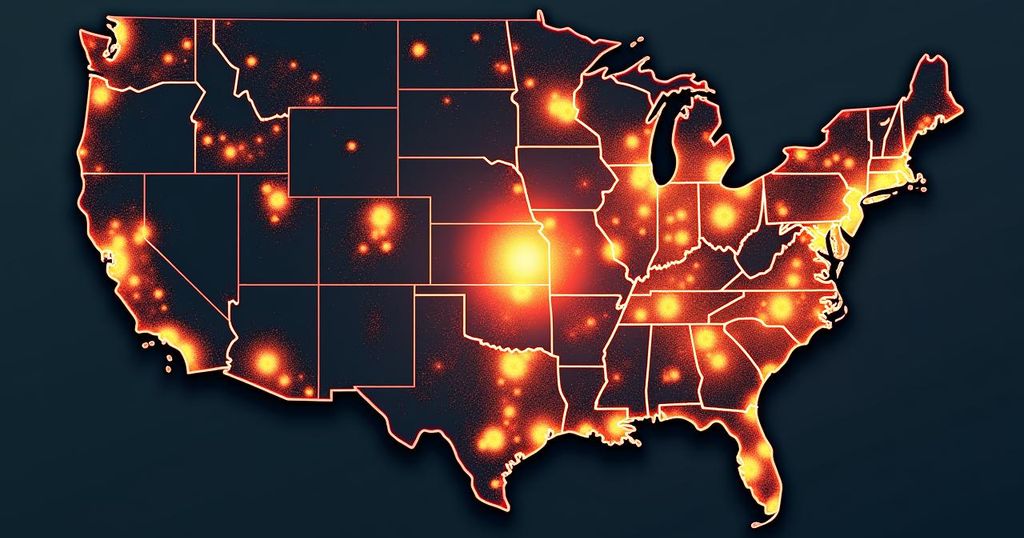Recent Earthquake Activity in the United States and Beyond: A Report on Seismic Events
A 4.1-magnitude earthquake struck Dillon, Montana, on October 7, 2023, at a depth of 13.7 kilometers. This event follows a series of recent earthquakes across the United States, including significant seismic activity in California, Tennessee, and Idaho, as well as notable events in Romania and the Northern Mariana Islands.
On October 7, a 4.1-magnitude earthquake occurred in Dillon, Montana, as reported by the United States Geological Survey (USGS). The earthquake struck at a depth of 13.7 kilometers (approximately 8.5 miles) and elicited around 120 reports from individuals who felt the tremor. This seismic event in Montana follows a sequence of recent earthquakes across the United States and beyond. Two days prior, on October 5, a 3.7-magnitude earthquake was detected in Petrolia, California, occurring at a depth of 10.0 kilometers (approximately 6.2 miles). This event was preceded by a 2.5-magnitude earthquake in Tennessee on October 3, which was centered at a depth of 9.7 kilometers (about six miles). Additionally, a 3.5-magnitude earthquake occurred along the Oregon coast on October 2, at a depth of 13.5 kilometers (about 8.4 miles), followed by another 3.5-magnitude earthquake in Avenal, California, the previous day, at a depth of 11.4 kilometers (about seven miles). The Avenal earthquake was shortly succeeded by another earthquake on the same day in Ontario, California, which registered a magnitude of 3.5 and occurred at a shallow depth of 4.1 kilometers (approximately three miles). Continuing this trend, a 2.7-magnitude earthquake was noted in Idaho on September 30, with its epicenter located in Bonners Ferry, at a depth of 9.1 kilometers (about 5.7 miles). Prior to the Idaho event, a significant 6.3-magnitude earthquake struck near Mauritius on September 26, recorded at a depth of 10.0 kilometers (approximately six miles), while a related 4.0-magnitude earthquake was documented in Saanichton, Canada, on the same day, which occurred at a depth of 52.0 kilometers (about 32 miles). This pattern of seismic activity continued with a 5.2-magnitude earthquake in Romania on September 16, originating near Cașoca at a significant depth of 133.5 kilometers (about 83 miles). The same day saw a 5.1-magnitude earthquake in Texas centered in Ackerly, with a depth of 8.2 kilometers (approximately 5.1 miles). In addition, a 3.4-magnitude earthquake was recorded in Kansas on September 19, traced to Danville at a depth of 4.9 kilometers (approximately three miles). Lastly, a 6.3-magnitude seismic event was noted in the Northern Mariana Islands on September 16, occurring in Saipan at a depth of 42.9 kilometers (about 26.7 miles), following a previous 3.4-magnitude earthquake in Malibu, California, on September 13 at a depth of 10.6 kilometers (approximately 6.6 miles). This series of earthquakes across various regions highlights the ongoing seismic activity affecting not only the United States but also international locations. Monitoring these events is critical for understanding geological activity and potential risks to affected communities.
Earthquakes are natural phenomena caused by the sudden release of energy in the Earth’s crust, resulting in seismic waves. The United States Geological Survey closely monitors these events and provides public information on their magnitude, location, and depth. Understanding the patterns and frequency of earthquakes is essential for assessing risks in specific areas and preparing for potential impacts on infrastructure and populations.
In summary, the recent earthquake in Dillon, Montana, reflects a pattern of seismic activity observed across various regions, with several earthquakes of differing magnitudes reported in states including California, Tennessee, and Idaho, as well as internationally in Romania and the Northern Mariana Islands. Continuous monitoring and reporting by the United States Geological Survey play a critical role in public safety and awareness regarding seismic activity.
Original Source: www.iheart.com




Post Comment